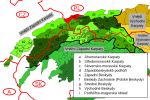Mazańcowice
Bielsko County geography stubsCieszyn SilesiaVillages in Bielsko County

Mazańcowice [mazaɲt͡sɔˈvit͡sɛ] is a village in Gmina Jasienica, Bielsko County, Silesian Voivodeship, southern Poland. It lies in the historical region of Cieszyn Silesia. The name of the village is derived from personal name Mazaniec (Mazanek). The name was first recorded (1305) with a typical Slavic ending -itcz (-ice), then it was also mentioned with a typical German ending -dorf (Mazanczendorff, 1452 and Matzdorff in 1566).
Excerpt from the Wikipedia article Mazańcowice (License: CC BY-SA 3.0, Authors, Images).Mazańcowice
Starobielska, gmina Jasienica
Geographical coordinates (GPS) Address Nearby Places Show on map
Geographical coordinates (GPS)
| Latitude | Longitude |
|---|---|
| N 49.857055555556 ° | E 18.979333333333 ° |
Address
Starobielska
Starobielska
43-391 gmina Jasienica
Poland
Open on Google Maps










